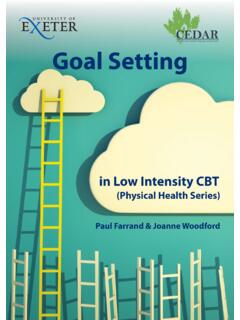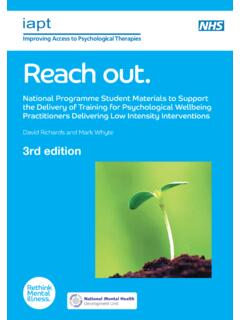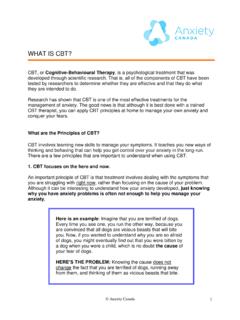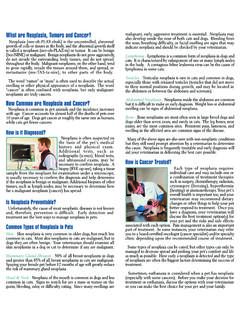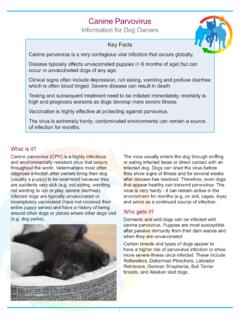Transcription of FACING YOUR FEARS - University of Exeter
1 FACING your FEARSA Cognitive Behavioural Therapy evidence based approach to help overcome phobias FACING your Fears3 FACING your FEARSW elcome!Well done for taking this step to try and get on top of your phobia. Seeking help can be one of the most difficult steps to FACING your FEARS workbook is based on an evidence-based psychological treatment known as Cognitive Behavioural Therapy (CBT). It will guide you through a CBT technique called Exposure and Habituation . This technique has been shown to help many people whose lives are affected by a phobia. This workbook is designed to be supported by a mental health professional trained to help people get the most out of it. This may be a Psychological Wellbeing Practitioner, often shortened to PWP, working within the Improving Access to Psychological Therapies (IAPT) programme in England. Given the success of this way of working, similar roles to that of the PWP working have also become increasingly available in other re in control of how quickly you work through this workbook and how you put the techniques into your FearsWhat is Exposure and Habituation?
2 When something causes us to feel afraid or scared, for example a specific object or situation, it s understandable we ll try to avoid it. Avoiding something that causes fear will provide us with relief from the unpleasant feelings we experience when we re afraid for example, a racing heart or shortness of breath. However, this will mean we feel just as scared the next time we re confronted with the situation or object causing us fear. This leads to the vicious cycle of fear and avoidance . Using the Exposure and Habituation technique helps you confront your FEARS and break into this vicious cycle in a supported and gradual way, helping you build up to confronting your FEARS in a way that will feel manageable to you. The result can be that you feel back in control of your FEARS and don t have to carry on avoiding situations. A lot of research has found Exposure and Habituation to be effective, especially for people experiencing fear of specific objects or situations.
3 Before getting started, it s important to find out a little bit more about the approach used in the FACING your FEARS workbook. You ll then be better able to decide whether using this technique is best for you. You ll also be helped to identify if there s anything that may be in the way of you getting the most out of the find out more about the FACING your FEARS workbook, let s read a little about Shay s story and how the approach was used to overcome a fear of s StoryI m 35 years old and have been terrified of dogs for as long as I can remember. I don t know where the fear came from but growing up my parents were scared of dogs too. I was becoming increasingly concerned that I might somehow pass on my FEARS to my son, Quinn. Since having Quinn, my fear had more of an impact on me; it was becoming harder and harder to avoid places where I thought there might be dogs. I was unable to take Quinn to play at a friend Sam s house, because they had a dog, so Sam would always have to come to our house instead.
4 I m sure Sam s parents would think I was rude. It even started affecting me in my own home if I heard a dog barking outside and watching TV was difficult if a dog came on the day I started to think about the impact my fear of dogs was having, how much Quinn was missing out on and it didn t seem right that I had to rely on my partner so much. So, I decided I needed to get on top of my fear but had no idea where to start! I searched the internet and found some information on the NHS Choices website about how something called Cognitive Behavioural Therapy could be helpful and I clicked on a link to find a free NHS service near me. I was really surprised as the service would allow me to refer myself. So I just filled in an online form and within a couple of days was offered an appointment with Barjinder, a Psychological Wellbeing Practitioner. When we met, Barjinder asked me a lot of questions about the things going through my head, how I felt in my body, things I was doing more or less of and how I was feeling.
5 At first all these questions seemed a bit odd and I couldn t see how they were relevant. I also felt a little embarrassed as I couldn t really identify any thoughts when I saw a dog, I just felt scared very quickly. However, when Barjinder related my fear of dogs to something called a Vicious Cycle, it started to make sense. For the first time, I could see that what I did and how I felt physically, impacted on one another and made my fear even spent some time talking about the idea of specific phobias that people develop. I had never thought of my fear of dogs as a phobia . Anyway, I d only heard of people having phobias around things like spiders, snakes and small spaces. But Barjinder taught me that people can have specific phobias about all sorts of things and that whilst fear 6 FACING your Fearsis a normal emotional response to danger in our environment, a phobia develops when the fear experienced is significant and persistent.
6 Also, a phobia is more commonly an irrational fear that is often greater than any actual or real threat posed by the thing we fear, in my case dogs. I didn t like the sound of this at first as my fear of dogs felt very real and very justified and I had read about dog attacks happening sometimes. Also, if there was nothing to fear why would even the mention of dogs make me feel so scared? I thought this must mean there was something to be scared of. Barjinder suggested a self-help workbook called FACING your FEARS based on something called Exposure and Habituation may be helpful. The idea of having to confront my fear of dogs still sounded terrifying. However, Barjinder then explained how I would start to face my FEARS in a graded and manageable way and go as quickly as I wanted to go with support available to overcome any difficulties if I ran into them. Each support session would last no longer than half-an-hour.
7 Given how busy work was for me, this sounded just about manageable, especially juggling work and a small child! It got even better when Barjinder said support was available over the telephone, this would save me from travelling on the bus to get to support sessions. Over the coming weeks, Barjinder helped me work through the workbook and this helped me really understand why I felt the way I did, even when I saw a picture of a dog and why I responded a particular way. The workbook then helped me work through the Exposure and Habituation approach. I can t say it was always easy but breaking my phobia down into manageable steps helped. I m really glad I completed this treatment as I m now able to do much more with Quinn. Last week I even took him to Sam s house and was invited in for a cup of tea, with Bingley their Basset Hound running around my legs. 7 Understanding the Vicious Cycle First of all, let s try to understand how your phobia may be affecting you by completing the different sections of the Vicious Cycle Worksheet.
8 It may first help to have a look at Shay s completed worksheet. Then, using the Vicious Cycle Worksheet overleaf, think about a recent time when your phobia was triggered and write down your emotions, physical feelings, behaviours and any thoughts you had at a time you were afraid and think about the impact this has on your SITUATIONW alking to the pa rk with Quin n a nd I see a dog by the gate. IMPACTQuin n missed out on the pa rk again a nd I feel bad a bout this. I end the day feeling terrible a nd e mba rrassed to tell my pa rtner. MY PHYSICAL FEELINGSI ncreased hea rt rate, tre mbling, qu easy, tense EMOTIONSSca red a nd a nxious. MY THOUGHTS Oh no, there s a dog, I ca n not go in the pa rk! I m feeling a bit qu easy a nyhow. MY BEHAVIOURSGra b my son tightly a nd get home as quickly as possible. 8 FACING your FearsMy Vicious Cycle Worksheet MY SITUATIONIMPACTMY PHYSICAL FEELINGSMY EMOTIONSMY THOUGHTSMY BEHAVIOURS 9 Breaking the Vicious Cycle Before we try to get on top of your phobia, it s worth spending a little time trying to understand how phobias develop and what keeps them going.
9 The Vicious Cycle of Fear and AvoidanceAs we can see in Shay s vicious cycle, when the dog was seen, physical feelings quickly became overwhelming and the behavioural response was to escape the situation and get home. This is a type of behaviour called avoidance . As we can see when the source of a phobia is avoided there will usually be a quick reduction in fear-related physical feelings and we start to feel better. Avoiding whatever is making us feel afraid may understandably feel the right thing to do. Anxiety level (%)100908070605040302010012345678910Ti me (minutes)Anxiety levels when we escape10 FACING your FearsMaintaining Our FearHowever, by simply avoiding whatever is causing us to feel fearful, we soon teach ourselves that avoiding the source of our fear feels better than confronting it. Avoidance brings us immediate relief and can soon create a pattern of avoidance . However, the next time we face the source of our phobia, our fear-related physical feelings quickly go up again and our pattern of avoidance starts again.
10 Over time, we learn that the only way we can manage our fear is to avoid the source of our phobia when it s encountered. This leads to the Vicious Cycle you have identified above. Anxiety level (%)100908070605040302010012345678910Ti me (minutes)Anxiety levels over time when we repeatedly escape11 Breaking the Vicious Cycle So, let s start to think about a way to break this Vicious Cycle. You ve hopefully identified that whilst avoiding whatever is causing fear can bring relief in the short-term, a pattern of avoidance prevents the fear from being reduced in the longer-term. A technique called Exposure and Habituation will help you overcome your fear when faced with the source of your phobia. This approach will support gradual exposure to the source of fear in a manner that s acceptable to you and help you identify what happens to your level of fear if you actually remain in the situation. What commonly happens when the situation is not avoided is that the level of fear will naturally come down, a process called habituation.







